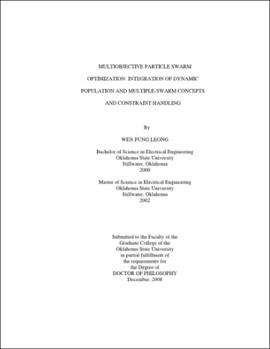| dc.contributor.advisor | Yen, Gary G. | |
| dc.contributor.author | Leong, Wen Fung | |
| dc.date.accessioned | 2013-12-10T18:05:49Z | |
| dc.date.available | 2013-12-10T18:05:49Z | |
| dc.date.issued | 2008-12 | |
| dc.identifier.uri | https://hdl.handle.net/11244/7860 | |
| dc.description.abstract | Scope and Method of Study: Over the years, most multiobjective particle swarm optimization (MOPSO) algorithms are developed to effectively and efficiently solve unconstrained multiobjective optimization problems (MOPs). However, in the real world application, many optimization problems involve a set of constraints (functions). In this study, the first research goal is to develop state-of-the-art MOPSOs that incorporated the dynamic population size and multipleswarm concepts to exploit possible improvement in efficiency and performance of existing MOPSOs in solving the unconstrained MOPs. The proposed MOPSOs are designed in two different perspectives: 1) dynamic population size of multiple-swarm MOPSO (DMOPSO) integrates the dynamic swarm population size with a fixed number of swarms and other strategies to support the concepts; and 2) dynamic multiple swarms in multiobjective particle swarm optimization (DSMOPSO), dynamic swarm strategy is incorporated wherein the number of swarms with a fixed swarm size is dynamically adjusted during the search process. The second research goal is to develop a MOPSO with design elements that utilize the PSO's key mechanisms to effectively solve for constrained multiobjective optimization problems (CMOPs). | |
| dc.description.abstract | Findings and Conclusions: DMOPSO shows competitive to selected MOPSOs in producing well approximated Pareto front with improved diversity and convergence, as well as able to contribute reduced computational cost while DSMOPSO shows competitive results in producing well extended, uniformly distributed, and near optimum Pareto fronts, with reduced computational cost for some selected benchmark functions. Sensitivity analysis is conducted to study the impact of the tuning parameters on the performance of DSMOPSO and to provide recommendation on parameter settings. For the proposed constrained MOPSO, simulation results indicate that it is highly competitive in solving the constrained benchmark problems. | |
| dc.format | application/pdf | |
| dc.language | en_US | |
| dc.rights | Copyright is held by the author who has granted the Oklahoma State University Library the non-exclusive right to share this material in its institutional repository. Contact Digital Library Services at lib-dls@okstate.edu or 405-744-9161 for the permission policy on the use, reproduction or distribution of this material. | |
| dc.title | Multiobjective particle swarm optimization: Integration of dynamic population and multiple-swarm concepts and constraint handling | |
| dc.contributor.committeeMember | Fan, Guoliang | |
| dc.contributor.committeeMember | Latino, Carl D. | |
| dc.contributor.committeeMember | Rhinehart, R. Russell | |
| osu.filename | Leong_okstate_0664D_2913 | |
| osu.accesstype | Open Access | |
| dc.type.genre | Dissertation | |
| dc.type.material | Text | |
| thesis.degree.discipline | Electrical and Computer Engineering | |
| thesis.degree.grantor | Oklahoma State University | |
